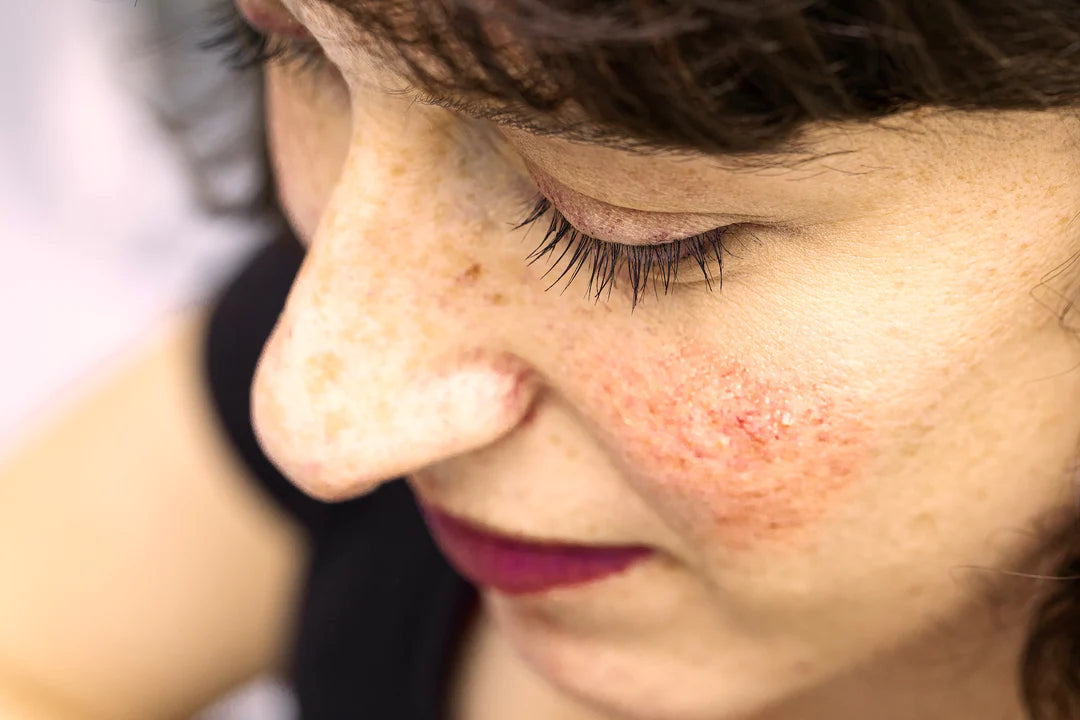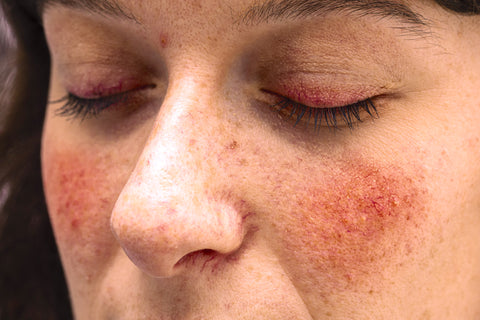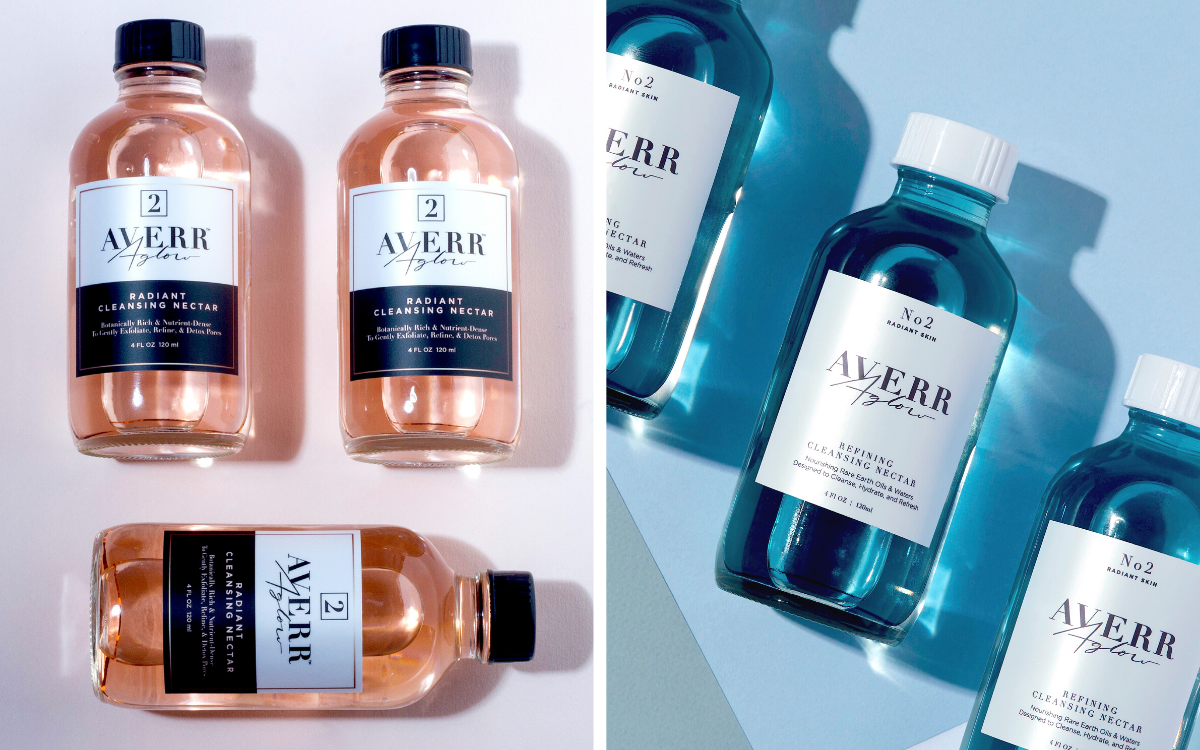
Dealing With Rosacea: Causes, Symptoms, Treatments, and Skincare Tips
For those of us with problematic complexions, it’s not always easy to cope with our skin issues. Maybe you’re still trying to identify the source of your suffering. You’ve had your allergies checked or plowed through every acne product on the market, all to no avail. It probably feels like you’ve tried everything. So why isn’t anything working?
If your skin is violently red for weeks at a time, or you find your face crisscrossed with visible veins, this may be a case of rosacea. Or perhaps you already know that it’s rosacea.
You don’t have to keep struggling alone in the dark. Let Averr Aglow help you navigate the depths of rosacea.
What is Rosacea?
Rosacea is a recurring skin condition that often begins with stubborn, rash-like redness across your face, particularly around your nose, cheeks, and forehead. The symptoms generally appear in cycles, periodically popping up for weeks or months at a time.
Pro tip: Rosacea is pronounced roh-ZAY-sha.
There is no cure for rosacea, and without proper care, your symptoms can worsen over time. Fortunately, though, the condition isn’t dangerous, and the symptoms can be managed.
Some people with rosacea manage their symptoms so well that you’d never guess they had it. So if you’re dreaming of a flawless finish, it’s not beyond your reach. Did you even realize that many familiar, red-carpet faces are dealing with rosacea, too?

Celebrities With Rosacea
- Cameron Diaz
- Renee Zellweger
- Prince William
- Mariah Carey
- Sofia Vergara
- Bill Clinton
- Cynthia Nixon
- Brie Larson
Rosacea is a common condition, affecting more than 415 million people across the globe. (That’s almost 20% of the population!) And that total could be even higher — rosacea can be difficult to identify, so there may be a lot more cases walking around undiagnosed.
Who Gets Rosacea?
Rosacea is an equal-opportunity skin condition, affecting anyone and everyone. How do you know if you’re in rosacea’s “target audience?” Well, it usually develops between the ages of 30 and 50, and your chances of having it are higher if there is a history of rosacea in your family tree.
Rosacea is more common among women, but men with rosacea tend to get more severe symptoms.
Many sources also suggest that rosacea is most frequent in people with lighter skin tones, especially Scandinavian types with blonde hair and blue eyes. So, do other skin types get off scot-free?
Alas, no. It’s currently unclear whether light-skinned people actually get rosacea more, or if it’s just diagnosed on lighter skin tones more often because it’s easier to see. In any case, people with melanin-rich complexions can certainly develop rosacea as well.
What Causes Rosacea?
Even though rosacea is a common condition, doctors still aren’t sure what causes it. It may be genetically passed down through families, or it could be triggered by environmental factors, or even result from a combination of both.
Some theories suggest that blood vessels swell beneath your skin and cause rosacea redness, or that tiny mites clog up your oil glands, leading to swelling and irritation.
Rosacea may even be triggered by the use of steroids.
Whatever the cause, recognizing rosacea can be tricky, as not all cases are identical. What’s affecting Cameron Diaz or Mariah Carey may look very different from the symptoms you’re experiencing. Rosacea can vary so much that doctors have divided it into several distinct categories.

The 4 Rosacea Types
Though we often use the general umbrella term “rosacea,” there are four different types of rosacea recognized by the American Academy of Dermatology. All four are forms of the same condition, but each is associated with slightly different symptoms.
- ETR (erythematotelangiectatic rosacea): This type of rosacea is perhaps the most iconic. It’s associated with red skin, heavy blushing, and visible, spidery blood vessels.
- Acne rosacea (aka papulopustular rosacea): True to its name, this variation of rosacea appears as acne-like breakouts with inflamed, pus-filled bumps. It’s most common among middle-aged women.
- Rhinophyma: This rare form of rosacea causes thickening of the skin around your nose, causing it to look swollen and bulbous. Rhinophyma usually affects men and often occurs hand-in-hand with another form of rosacea.
- Ocular rosacea: This type of rosacea is centered around your eyes, causing a burning sensation, eyelid swelling, wateriness, and general discomfort.
Can’t quite place your symptoms in one category or another? Still, desperately trying to guess between ETR and acne rosacea?
It’s possible to have more than one subtype at a time or to begin with one and develop another later. To narrow it down, let’s take an even deeper dive into the various hallmarks of rosacea.
Rosacea Symptoms
Rosacea is often confused with regular acne, eczema, or an allergic reaction, especially since there’s no clinical test for rosacea. Doctors must rely on your symptoms and triggers to help shape their diagnosis.
But this isn’t always straightforward. Some symptoms of rosacea tend to be universal, while others are particular to their subtype.
So where do you begin? If you’re wondering whether you have rosacea, you can start by checking the symptoms most common to rosacea. Remember, they are most likely to occur across your face — or, occasionally, on your ears, neck, or chest.

Common Rosacea Symptoms
1. Flushing and redness (almost like a sunburn)
2. Broken or visible blood vessels (aka spider veins)
3. Sensitive, easily irritated skin
Next, you can try to narrow down your particular flavor of rosacea by observing any symptoms specific to a subtype.
Rosacea Symptoms By Subtype
ETR rosacea:
- Swelling
- A stinging or burning sensation
- Dry, rough, and scaly skin
Acne rosacea:
- Acne-like breakouts and very red skin
- Oily complexion
- Raised patches of skin
Rhinophyma:
- Thick, bumpy skin around your nose
- Thick skin on your chin, forehead, cheeks, and ears
- Enlarged pores
Ocular rosacea:
- Bloodshot, watery eyes
- Burning or stinging sensation in the eyes
- Dry, itchy, or gritty-feeling eyes
- Light sensitivity or diminished vision
- Cysts on eyes
For some people, rosacea symptoms will seem the same from flare-up to flare-up. But for others, the symptoms may gradually get worse, leading to permanently enlarged pores and visibly broken capillaries.
Tips to Spot Rosacea on Darker Skin Tones
If you are blessed with extra melanin, some of these rosacea symptoms won’t be very obvious. Instead, we recommend using this cheat sheet to help identify symptoms in your darker skin.
- Constantly feeling warm or flushed
- Extremely dry skin
- Dark patches or brown discoloration
- Acne-like breakouts
- Hard, yellow-brown bumps around your eyes and/or mouth
- Sensitive skin that burns or stings when you apply the product
- Swollen or extra-thick skin on your forehead, nose, cheeks, or chin
Rosacea Triggers
While we don’t know the exact cause of this condition, experts have implicated certain food and lifestyle factors as rosacea troublemakers. By moderating your exposure to these triggers, you may also be able to moderate your symptoms.
Granted, you probably won’t be able to avoid all these triggers all the time. Who could commit to such a restrictive lifestyle? However, it can still be helpful to recognize a trigger when you encounter it.
First, dietary triggers. When it comes to your eating habits, some foods can antagonize your rosacea, such as:
- Dairy products
- Spicy foods and hot peppers
- Caffeine
- Alcohol
- Foods containing cinnamaldehyde (like cinnamon, chocolate, tomatoes, or citrus fruits)
- Very temperature-hot foods or drinks
Other factors can also irritate your rosacea by increasing blood flow to your sensitive skin. These include:
- Extreme temperatures
- Sun and wind exposure
- High levels of stress
- Vigorous exercise
- Hot baths and saunas
- Certain medical conditions, such as a cold, cough, fever, or high blood pressure
- Some medications, like corticosteroids and blood pressure drugs
Feeling overwhelmed? It’s okay. Remember, no one expects you to completely cut all of these things out of your life. Rosacea doesn’t have to mean a life of restriction.
Instead, you can complement your attempts at moderation by learning how to treat rosacea in other ways.
Finding the Right Rosacea Treatment
Since there is no end-all, be-all cure, treatments for rosacea usually focus on controlling the symptoms. With the right steps, you can help prevent, shorten, and lessen your rosacea flare-ups.
Medical Treatments for Rosacea
Depending on the severity of your rosacea, you may feel like medical treatments are the path forward. As always, first, ask your dermatologist for their personalized recommendations.
- Topical creams. Prescribed by your doctor, certain ointments can help soothe inflammation and discoloration during a flare-up.
- In-office laser therapy. Certain lasers can minimize blood vessels, reduce redness, and help combat thickening skin. However, laser therapy has been known to cause bruising, tenderness, swelling, and skin crusting. Consult a medical professional to figure out whether this is the right choice for you.
- Eye drops to calm ocular rosacea. If you have ocular rosacea, you’ll need special precautions for your vulnerable eyes. Speak to a medical professional about prescription eye drops and other options.
- Oral or topical antibiotics. These can help reduce swelling and other symptoms, but should not be taken continuously. Too many antibiotics can disrupt your immune system, so carefully follow the advice of your doctor.
- Microdermabrasion or acid peels. These treatments may be suggested for rough or thickening skin, but proceed carefully. Because rosacea makes your skin extra sensitive, you may have a negative reaction to such strong treatments.
A lot of these treatments have upsides and downsides. So you may be wondering, is medical treatment for rosacea the only answer? Isn’t there anything else I can do?
Of course, there is. Because whether or not you’re ready to take the plunge with medical treatments, good skincare is a rosacea must-have.

Ways to Build a Rosacea-Friendly Skincare Routine
When you’re struggling with a sensitive, rosacea-prone complexion, not any old skincare will do. The constant inflammation caused by rosacea can undermine your skin barrier, leaving it vulnerable. Then it’s all too easy for irritants to enter your skin, including some widely-used skincare ingredients.
Most people with rosacea have dry complexions, so you’ll thrive best with products that infuse your skin with nourishment without irritating or stripping away your natural oils. For best results, you can try incorporating these tips and guidelines as you craft your perfect, rosacea-friendly skincare routine.
- Use mild, non-irritating products, and avoid harsh or drying ingredients, such as alcohol, menthol, eucalyptus, artificial fragrances, rough exfoliants, and retinoids.
At Averr Aglow, our skincare is crafted with sensitive complexions in mind, without harsh chemicals or artificial fragrances. (And who needs retinoids when you can use rejuvenating, rosacea-safe bakuchiol?)
- Set aside rough washcloths or sponges, and instead apply products with the lighter touch of your fingertips or a cotton pad.
- Cleanse with cool or lukewarm water, avoiding extreme hot or cold temperatures. Or, even better, try a rinseless cleanser that preserves your natural oils and skin barrier, like our classic Radiant Cleansing Nectar. Enriched with manuka and jojoba oils, it nourishes and supports the intrinsic health of your skin.
- After a shower, dry your face by gently blotting with a soft towel, rather than wiping or scrubbing.
- Dry skin is a quick shortcut to a rosacea flare-up, so keep your skin hydrated with a gentle moisturizer. To infuse your complexion with luxurious hydration, you can’t go wrong with a balmy option like our Flawless Nourishment Cream. Its vitamin-rich formula penetrates deep to quench your skin’s thirst.
- Use a daily SPF to protect against sun-triggered rosacea. (Ideally, a sunscreen that protects against both UVA and UVB rays.) Note: Chemical sunscreens may irritate sensitive skin, so consider a mineral-based SPF instead.

Rosacea and Makeup
Your skin doesn’t define you, and you shouldn’t feel pressured to hide the symptoms of your rosacea. But if you want to cover that redness with makeup, choose a heavier, full-coverage foundation. Light formulations may not provide the even finish you’re looking for.
Dermatologists also suggest seeking out makeup that is mineral-based and preservative-free, which may be less aggravating to sensitive, inflammatory skin types like rosacea.
Other Tips to Help Ease Your Rosacea Symptoms
Treatments, check. Skincare, check. You’re on a roll, and ready to bring your rosacea to heel. Are there any other ways you can support your complexion?
There are. To complete your holistic, rosacea-friendly lifestyle, you can mix and match these tips to help keep your skin healthy and glowing.
- Avoid triggering foods. Again, dodging triggers can help keep your skin calm. Try using a food journal to track which foods consistently irritate your skin, and then minimize those foods as much as possible.
- Try not to rub or touch your face, which can contribute to irritation. It’s like scratching a bug bite — scratching may feel good at the moment, but it will probably make the itch worse in the end.
- In cold weather, protect your face from the wind and low temperatures with a cozy scarf or snood.
- Swap your razor for an electric shaver. These are less likely to aggravate your skin.
- Avoid over-the-counter steroid creams unless specifically directed by a doctor. These may worsen your symptoms in the long term.
- Practice stress-reducing techniques, such as meditation and getting quality sleep. Calming your mood can lessen stress-induced flare-ups. (Just remember that certain stress reducers aren’t the best choice for rosacea. We see you, hot baths.)
We know that some of these tips are simpler to enact than others. Like, “manage your stress?” Easier said than done, especially when you have anxiety about your skin. That’s where healthy coping strategies come into play.
Coping With Rosacea
Rosacea may not be Dangerous with a capital D, but it can still hurt your mental and emotional well-being. Of course, we don’t have to tell you that. How often do you feel burdened by the seeming endlessness of your struggle? When symptoms show up, do you find yourself battling frustration, embarrassment, or low self-esteem?
You aren’t alone. Nearly 90% of rosacea patients have struggled with their confidence.
Remember, rosacea is a common condition. If you’re struggling, there are resources out there to help keep you afloat. Try joining rosacea support groups and message boards, where you can meet thousands of people out there facing the same challenges.






